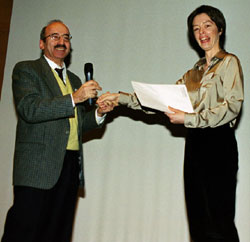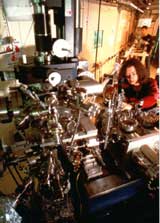- Home
- News
- General News
- The Young Scientist...
The Young Scientist Award goes to Claudia Dallera
20-02-2003
Share
|
Claudia Dallera, an ESRF User from the institute Politecnico di Milano, received this year's Young Scientist Award at the 13th Users' Meeting, held on 12 February 2003. This prize recognises her outstanding contribution to instrumentation and spectroscopy(1). |
| She talked about spectroscopy and high-energy photoemission(2) with such passion, that it was a real pleasure to hear her giving a presentation. Devotion to her work and contribution to science made Claudia Dallera the preferred candidate out of the nine nominees for the 2003 Young Scientist Award. For this young scientist, the first woman to get this prize, it was a real surprise: "I didn't expect it and it certainly has a special meaning to me, since I started my research career at the ESRF". Indeed, the walls of the ESRF have witnessed the evolution of her scientific work since her research started with the design of a spectrometer for a beamline eleven years ago. |
 |
|
Claudia Dallera receives the prize from Prof. Settimio Mobilio, responsible for the Italian beamline Gilda. |
 |
At present, Claudia works at the Department of Physics of the Politecnico di Milano, where her main activity involves an autonomous research program as well as teaching duties. This is the seventh edition of the "Young Scientist of the Year" award, for which a prize of 1500 euros was given. The award is presented every year by the Users' Organization for outstanding work done at the ESRF by a scientist 35 years of age or younger. The first winner, in 1995, was Francesco Sette, now Director of Research at the ESRF. |
|
Claudia Dallera working on the beamline in 1995. |
|
|
|
2002 2001 2000 1999 1997 1996 1995 |
Lawrence Margulies (Materials Science) Guillaume Fiquet (Earth Sciences) Richard Neutze (Time-resolved Biology) Peter Cloetens (X-ray Imaging) Michael Thoms (Development of a detector) Paul Loubeyre (High-pressure Science) Francesco Sette (Inelastic X-ray Scattering) |
|
(2) Photoemission: This technique consists in measuring the energy of the electrons emitted by a sample of matter when it is illuminated by high-energy photons. It is normally a surface-sensitive technique, but has also been used by Claudia Dallera to probe the bulk. |



